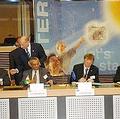 世界七國政府24日草簽一項「國際熱核實驗反應裝置」(ITER,International Thermonuclear Experimental Reactor)研究協定,鑑此,開發核融合發電作為新能源用途之計劃更趨實現。該計劃將試圖利用同樣讓太陽與其他星體發光的巨大能量;批評人士則認為ITER計劃不但不安全、還有損保育工作,甚至排擠再生能源發展的經費。
世界七國政府24日草簽一項「國際熱核實驗反應裝置」(ITER,International Thermonuclear Experimental Reactor)研究協定,鑑此,開發核融合發電作為新能源用途之計劃更趨實現。該計劃將試圖利用同樣讓太陽與其他星體發光的巨大能量;批評人士則認為ITER計劃不但不安全、還有損保育工作,甚至排擠再生能源發展的經費。
過去一年以來,中國、歐盟、印度、日本、南韓、俄國及美國即就上述協議的簽署事宜展開磋商,至本月24日,各國部長級官員在歐盟執委會位於布魯塞爾的Berlaymont大樓會商,終於就協議內容的最初版本定稿;會中並決議ITER核融合裝置的興建及運轉,將落腳法國南部的卡達拉希(Cadarache)。
作為能源之一,核融合有幾項吸引人之處:它的基本燃料蘊藏豐富並且隨處可得,且沒有溫室氣體排放問題。與現今普遍用以產生核能的核分裂相較,它沒有放射性原料運輸的問題,也沒有反應爐核心熔毀的可能性或幅射外逸問題,更沒有將持久性放射性廢料遺留給我們下一代的問題。
歐洲「地球之友協會」的能源議題負責人赫曼(Silva Hermann)指出:「核融合可能永遠都無法在經濟上或技術上實現。這雖然是個新技術,但已然是和現實相去近50年。其商業運轉目標不斷在變動,我們無法保證這目標能夠真正達成。」
ITER計劃是要設立一個實驗反應爐,以再現太陽和其他恆星內部的原子核融合反應。現今的實驗顯示,這個反應過程有可能在地球上重現。ITER計劃旨在證明在這樣的規模和條件下,核融合作為一個實用能源的科學理論和技術都是具有相當可行性的。
ITER計劃的科學家解釋,核融合對於工作人員以及卡達拉希森林(ITER設備興建處)週邊人民而言,是安全無虞的。雖然如此,批評人士仍是憂心忡忡。有些人士認為ITER計劃將會消耗掉法國電力網絡的電力資源,遠遠超出它所能生產的電力。另外有些人則認為它會打擊保育工作。
華府反核團體「核子資訊及資源服務」(Nuclear Information and Resource Service)執行長麥里歐提(Michael Mariotte)指出:「ITER計劃中的核融合反應器是一個毫無能源回饋並大量浪費公帑的科學計劃。ITER計劃將動用億萬美元的公部門經費,排擠掉真正針對世界氣候變遷危機所採取的綠色能源方案。」
 A project to demonstrate the potential of nuclear fusion as an energy source moved a step closer to realization today as the seven governments initialed an agreement on the research facility. Known as ITER, the project will attempt to harness the same type of energy which powers the Sun and other stars. Critics say ITER is unsafe, discourages conservation, and draws funds from renewable energy development.
A project to demonstrate the potential of nuclear fusion as an energy source moved a step closer to realization today as the seven governments initialed an agreement on the research facility. Known as ITER, the project will attempt to harness the same type of energy which powers the Sun and other stars. Critics say ITER is unsafe, discourages conservation, and draws funds from renewable energy development.
This morning, ministers representing China, the European Union, India, Japan, South Korea, Russia and the United States of America met in the European Commission Berlaymont Building in Brussels to initial the agreement they have been negotiating over the past year. They have selected a site for the construction and operation of ITER at Cadarache in southern France.
Fusion has several attractions as an energy source - its basic fuels are abundant and available everywhere, and there are no greenhouse gas emissions. As compared to nuclear fission, universally used today to generate nuclear power, there is no transportation of radioactive materials, no possibility of meltdown or runaway reactions, no long-lasting radioactive waste to be passed on to future generations.
Silva Hermann, energy campaigner at Friends of the Earth Europe said, "Nuclear fusion may never be economically or technically practical. It is a new technique that has been a few decades away from reality for nearly 50 years. This goal of commercial viability has become a moving target and we have no guarantee that it will ever actually be reached."
ITER is an experimental reactor which will reproduce the physical reaction of fusing the nuclei of atoms that occurs in the Sun and stars. Existing experiments have shown that it is possible to replicate this process on Earth. ITER aims to do this at a scale and in conditions that will demonstrate the scientific and technological feasibility of fusion as a practical energy source.
ITER scientists explain that nuclear fusion is safe for workers and for the population surrounding the ITER facility in France's Cadarache forest. Still, critics are uneasy. Some say ITER will draw more power from the French electricity grid than it will produce. Others say it discourages conservation.
Michael Mariotte, executive director of the Nuclear Information and Resource Service based in Washington, DC, has said, "The ITER fusion reactor is a big-science boondoggle that has no energy payback. ITER will divert billions of dollars away from real green energy solutions to the world's climate change crisis."



